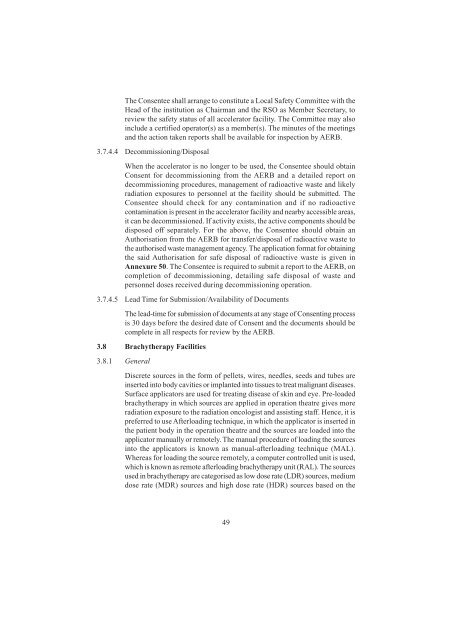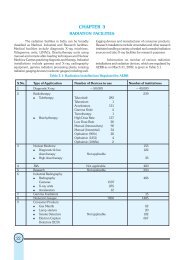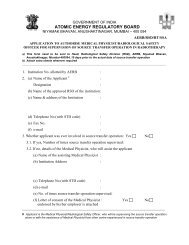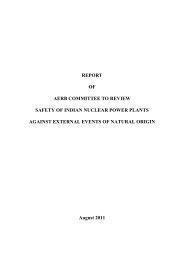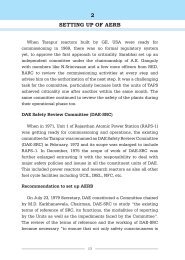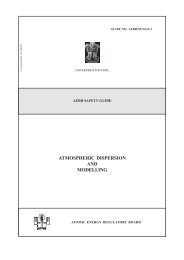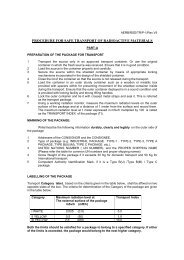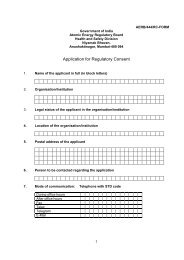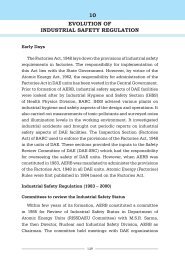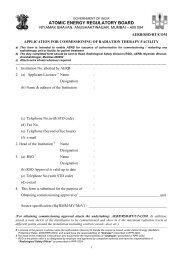Consenting Process for Radiation Facilities - Atomic Energy ...
Consenting Process for Radiation Facilities - Atomic Energy ...
Consenting Process for Radiation Facilities - Atomic Energy ...
You also want an ePaper? Increase the reach of your titles
YUMPU automatically turns print PDFs into web optimized ePapers that Google loves.
The Consentee shall arrange to constitute a Local Safety Committee with the<br />
Head of the institution as Chairman and the RSO as Member Secretary, to<br />
review the safety status of all accelerator facility. The Committee may also<br />
include a certified operator(s) as a member(s). The minutes of the meetings<br />
and the action taken reports shall be available <strong>for</strong> inspection by AERB.<br />
3.7.4.4 Decommissioning/Disposal<br />
When the accelerator is no longer to be used, the Consentee should obtain<br />
Consent <strong>for</strong> decommissioning from the AERB and a detailed report on<br />
decommissioning procedures, management of radioactive waste and likely<br />
radiation exposures to personnel at the facility should be submitted. The<br />
Consentee should check <strong>for</strong> any contamination and if no radioactive<br />
contamination is present in the accelerator facility and nearby accessible areas,<br />
it can be decommissioned. If activity exists, the active components should be<br />
disposed off separately. For the above, the Consentee should obtain an<br />
Authorisation from the AERB <strong>for</strong> transfer/disposal of radioactive waste to<br />
the authorised waste management agency. The application <strong>for</strong>mat <strong>for</strong> obtaining<br />
the said Authorisation <strong>for</strong> safe disposal of radioactive waste is given in<br />
Annexure 50. The Consentee is required to submit a report to the AERB, on<br />
completion of decommissioning, detailing safe disposal of waste and<br />
personnel doses received during decommissioning operation.<br />
3.7.4.5 Lead Time <strong>for</strong> Submission/Availability of Documents<br />
The lead-time <strong>for</strong> submission of documents at any stage of <strong>Consenting</strong> process<br />
is 30 days be<strong>for</strong>e the desired date of Consent and the documents should be<br />
complete in all respects <strong>for</strong> review by the AERB.<br />
3.8 Brachytherapy <strong>Facilities</strong><br />
3.8.1 General<br />
Discrete sources in the <strong>for</strong>m of pellets, wires, needles, seeds and tubes are<br />
inserted into body cavities or implanted into tissues to treat malignant diseases.<br />
Surface applicators are used <strong>for</strong> treating disease of skin and eye. Pre-loaded<br />
brachytherapy in which sources are applied in operation theatre gives more<br />
radiation exposure to the radiation oncologist and assisting staff. Hence, it is<br />
preferred to use Afterloading technique, in which the applicator is inserted in<br />
the patient body in the operation theatre and the sources are loaded into the<br />
applicator manually or remotely. The manual procedure of loading the sources<br />
into the applicators is known as manual-afterloading technique (MAL).<br />
Whereas <strong>for</strong> loading the source remotely, a computer controlled unit is used,<br />
which is known as remote afterloading brachytherapy unit (RAL). The sources<br />
used in brachytherapy are categorised as low dose rate (LDR) sources, medium<br />
dose rate (MDR) sources and high dose rate (HDR) sources based on the<br />
49


